by aramatzne@gmail.com | 30 Sep 2018 | Roads Taken
Town
I understand now that the sun is too low on the horizon to clear the mountains around Longyearbyen; I look forward to sailing into the sunshine on Monday. Below are a few more shots around town.
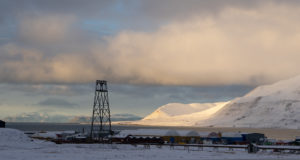
Sunshine so far away.
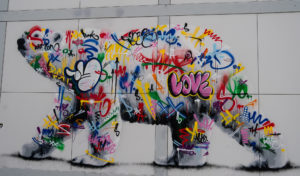
A stylish/stylized/styling polar bear all dressed up for a day on the town.
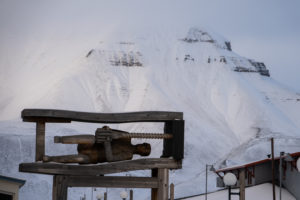
The unknown miner drills into mid-town coal reserves.
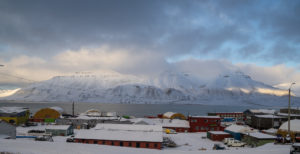
Sun catches both ends of the mountains across the fjord but stays out of town this time of year.
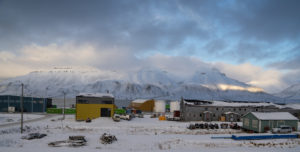
The mountains across Isfjorden catch a few late afternoon rays.
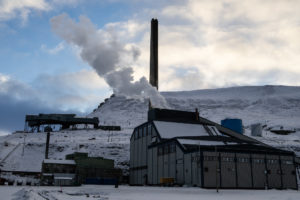
The old coal cableway looks down upon the current power plant. No indication of what keeps the new plant firing.
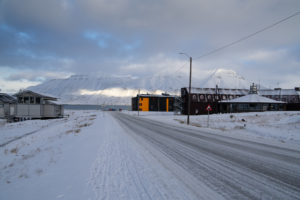
All roads lead to Isfjorden and views of Nordre Isfjorden National Park beyond.
by aramatzne@gmail.com | 29 Sep 2018 | Roads Taken
At long last
Finally, I landed on Svalbard yesterday morning. It seems a long time coming and now, here I am. The air is cold and dry, the sun lingers at the top of the all-encompassing mountains but doesn’t seem to find its way into the valley where Longyearbyen is nestled. Snow fell quietly through the evening and into the morning. Tomorrow the rest of The Arctic Circle residents arrive; we sail on Monday.
Here are my first views and impressions. I do not expect to have cell service or internet over the coming weeks. I promise to check in as soon as I can. Stay warm and see you here again soon. xoxo T
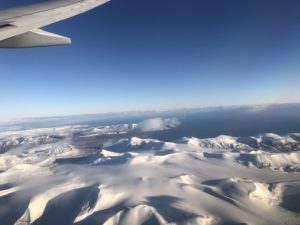
The first view of Svalbard
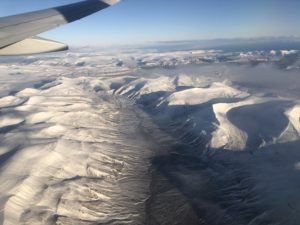
An open glacial valley with a braided stream in the bottom wends its way through inland Svalbard.
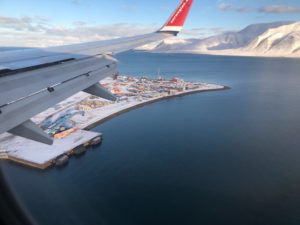
Flying into Longyearbyen, Svalbard, Norway.
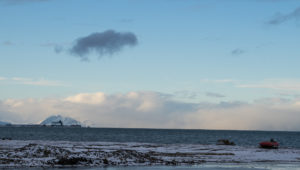
Snow squalls move across Isfjorden toward Longyearbyen, later engulfing the mountains, port, and town.
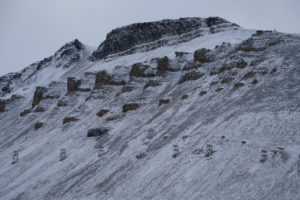
Repeating patterns of rock and power towers in early autumn snow.
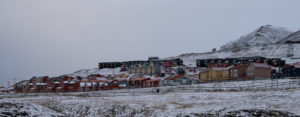
The multicolored housing of Longyearbyen contrasts with the monochromatic scheme of Svalbard.
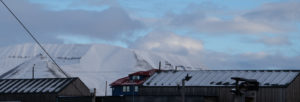
Metal roofs in Longyearbyen imitate mountain ridge lines.
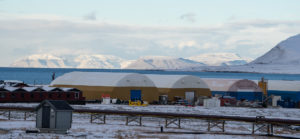
Modern Quonset huts mimic the position and image of mountains across Isfjorden.
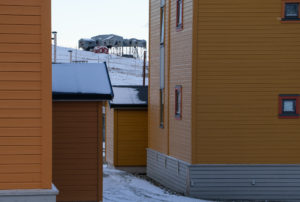
The old coal cableway oversees new apartment buildings. The cableway was used to transfer coal from the mines to ships in Isfjorden.
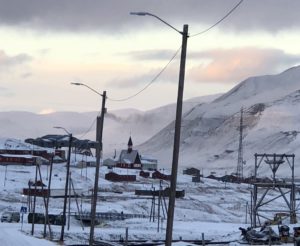
The church and the coal cableway share the hillside above Longyearbyen.
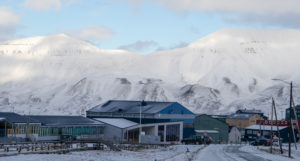
Longyearbyen School stands at the edge of town, the mountains of Nordre Isfjorden National Park stand behind the school across Isfjorden.
by aramatzne@gmail.com | 20 Sep 2018 | Musing
Reality
There is no going back.
We all know the results of our collective actions, we see it daily in raging hurricanes, in photos of starving polar bears, and microplastics in alpine lakes and city water supplies alike. The hundreds, perhaps thousands, of conservation organizations, environmental advocates, and ecological prophets bend ears at every opportunity; if we can reach the children, the lawmakers, the governments, surely things will change, surely we will make a difference. We lament the loss of things many will never see outside of TV or a zoo – elephants and tigers, glaciers and polar ice caps.
A dream
I point no fingers, as I am guilty, too: I drive, I fly, I use more water than necessary, I appreciate many comforts of modern living.
I go to Svalbard next week with the dream of connecting people to a world they may never experience, to a place that bears the brunt of our time, and does so stoically, as those with the gravest injuries tend toward silence while the superficially wounded produce the loudest caterwauling. How long before we recognize the consequences of our actions? How long before we bring the Arctic and its denizens to their knees?
I don’t pretend to have the answer. I am not so arrogant to think that my trip will change the face of our culture nor our fate. I believe we each have a role and every person who connects with the natural world becomes sympathetic to its plight. To our plight. We are not separate.
I am in pursuit of this connection. For myself, yes, but also for the wild upon which we depend, for it depends equally upon us.
I will have limited to no internet over the coming weeks. Bear with me; I will post what I can. I look forward to catching up here when I return to stable wifi. In the meantime, wish me many polar bears and stunning northern lights.
Stay on the sunny side. xoxo T
by aramatzne@gmail.com | 10 Sep 2018 | Roads Taken
Retreat
Lake Albigna, near Vicosoprano, Switzerland, 2,163m (7,096 ft) above sea level, was dammed for hydropower in the 1950s, a gondola was built to transport equipment and workers to the base of the glacier fields. Today, the gondola carries hikers and rock climbers to see the spectacular indescribable color of the glacial lake, to climb the granite walls, and to hike through alpine meadows. The glaciers are disappearing rapidly; the lake is not far behind.
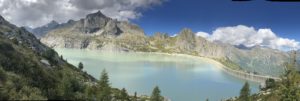
The engineered lines of Albigna Dam stand high above the Bergell Valley in southern Switzerland.

Built in the 1950s, the Albigna Dam created a glacial lake of stunning of color and power-producing utility.
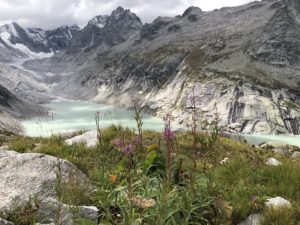
Albigna Glacier retreats into its valley.
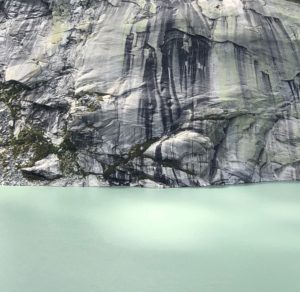
The indescribable color of glacial water contrasts with the texture of mountain rock.
by aramatzne@gmail.com | 3 Sep 2018 | Musing
Then
Cooper Island seems a lifetime ago, the light, the endless bird calls, the sand, the cold and eternal, infernal wind. They are far away now. I returned to Cooper the following summer for a shorter stay, and after demanding a wall tent in which I could stand up and be out of the wind simultaneously. By then George met Darcy Frey and the momentum of Cooper drastically increased as Darcy visited the island, interviewing George and me; later Joe McNally came to photograph Cooper and its residents, avian and otherwise. The story was published in the New York Times Sunday Magazine, George Divoky’s Planet, in 2002. Climate change was under debate (yes, even then and even still) and George’s 30-year data set was a prime source of intrigue. The birds George studied definitively returned to their mutual island almost two weeks earlier than when he began summering, and I use the term loosely, on Cooper Island.
Black Guillemots are cavity nesters; when the winter’s snow and ice retreat sufficiently to allow birds to enter their cavities, make it cozy, and spend time, well, nesting, they return. First, there are some flybys, birds stay in the air, doing visual reconnaissance; how much snow is there on their chosen sand spit? Are the nest sites visible? Flybys become fleeting landings, a strut or two along the ground or a momentary claiming of the nest box, snow preventing entering but exposure allowing dibs, if you will. Finally, birds arrive in droves, the mating rituals begin, and the birds settle into family life, breeding, eggs, chicks, frenetic but fleeting teenage days, and fledging. All racing against the spin of the Arctic seasons that until recently favored the dark, cold months.
As the climate continues to change and shift in ways we mere mortals can only guess, the birds long ago began to play the odds, returning earlier with the expectation that their summer homes will be open and inviting earlier this year than last. And, of course, we, mere mortals, are responsible for the Guillemots’ extended summering. Argue what you like, the world is changing and the creatures we so readily dismiss as animals are way ahead of us in understanding and appreciating the implications. They may not discuss it in political terms or devise computer models to help predict their future, but they recognize the current, if limited, advantage or disadvantage that it presents.
As Guillemots nest earlier each decade, polar bears are forced off the ice as it disintegrates beneath them. Traditionally following the ice north through summer, bears are left swimming farther than possible or are forced to be land-bound through summer. Their lives are made by the heavy winter cold and the extensive pack ice on which they travel and hunt. The small gain for guillemots is an enormous loss for polar bears. And, yes, polar bears are a more charismatic species receiving more attention, but, of course, the world is a poorer place for the loss of any species.
While being able to nest a few weeks early appears beneficial on the surface, the reality is Guillemots feed along the ice pack edge. As eggs are laid, and chicks develop, overworked Guillemot parents repeatedly fly to the pack ice to feed themselves and return to Cooper with one fish at a time for their growing young. When the pack ice is near, this equals fat and happy chicks with plenty of Arctic cod to help them grow toward fledging. As the pack recedes from shore and the distance increases, chicks feed less often; parents burn more of their strength commuting and are sometimes required to shift to less desirable forage fish. The location of the ice can change many times through a season; but as the overall size of the pack decreases, the time it is within range of the breeding colony can also decrease.
Now
At times in the past, pack ice was sometimes far offshore and the colony had a dismal showing for the summer’s work. But Guillemots are long-lived birds and the following year provided new opportunities. Now, pack ice consistently does not form as early, nor stay as late. It is not as thick; it retreats farther from shore. It breaks up earlier and provides a less cohesive mass. Being far offshore is the norm, rather than the exception. All of this potentially leads to reduced fitness and productivity.
Where am I going with this? These small threads simply laid out here are the tiniest fraction of all the pieces that fit together to make our world what it is. The intricacy of connections, circumstances, and continuity is, with all of our advanced science and knowledge, still mostly guessed. Each discovery is accompanied by dozens of questions. For all of our bluster and arrogance, we are repeatedly humbled by findings that take us to new places and show us the error of our previous certainties (think blood-letting, asbestos, and nuclear weapons).
To tie some of these threads together for myself, I am embarking on a residency to Svalbard, a Norwegian territory east of Greenland and above the Arctic Circle. Relative to Cooper, many things are different: it is an archipelago, it will be autumn, it will be dark most of the day, and colder than Cooper in summer, the chaotic summer life will have moved south by the time I arrive. The world and I are 18 years older. I see this as the next phase in the Cooper process, a progression of seasons being redefined as we live them.
As I was writing this, I briefly lost the post in the ether; saving the draft returned a blank page. After much swearing, and an impossible attempt to string the ones and zeros of my words together again, I found the draft invisibly saved in the blog menu. Now, this occurrence neatly ties my thoughts together.
What do we know of the fabric of the Arctic? What do we know of things lost and what can we surmise from the departed? What happens when the richly wrought landscape becomes a blank page? There is no backup menu or replacement post. It is there, or it is not. Much like the lost post, how the threads unravel and disintegrate into the void, is unknown. What we do know is that stringing new ones and zeros together in a way that resembles the original is impossible.
I would be delighted to have you join me virtually for the trip to Svalbard. There is much to be learned and explored. There is much more to the natural world than ones and zeros.






















